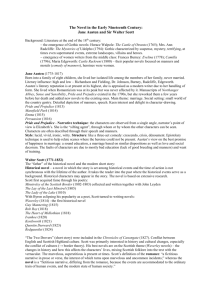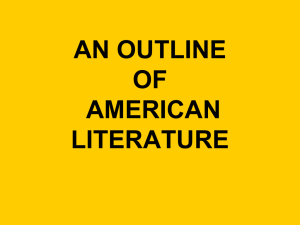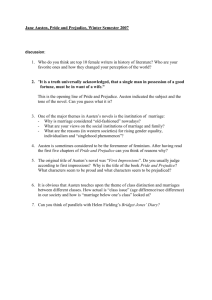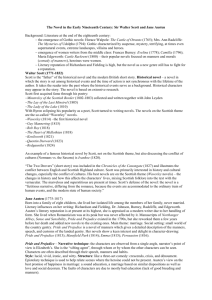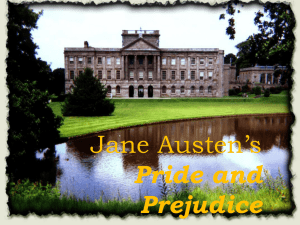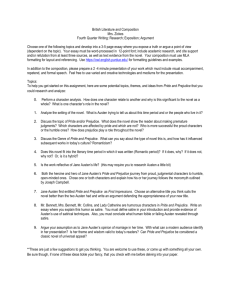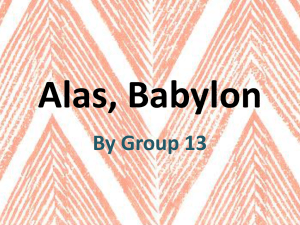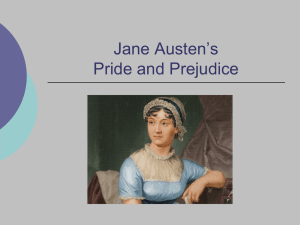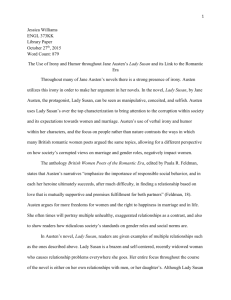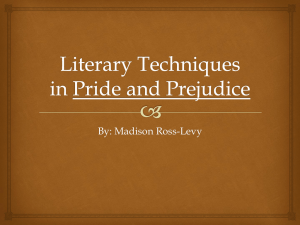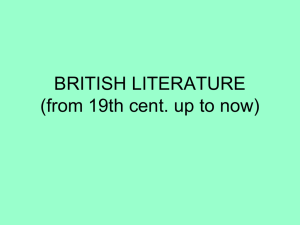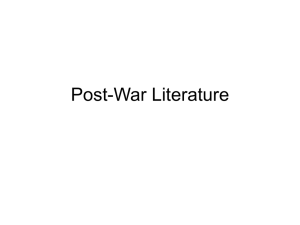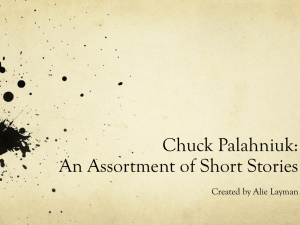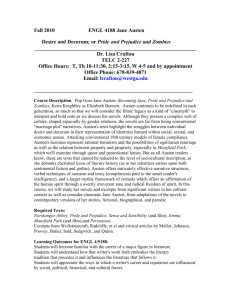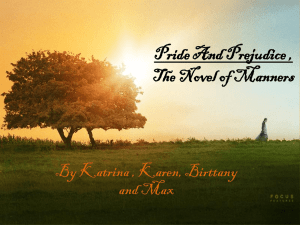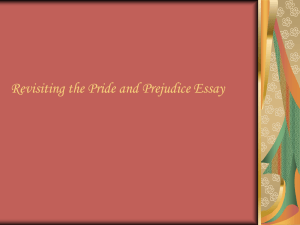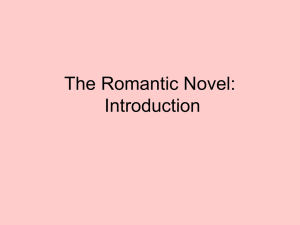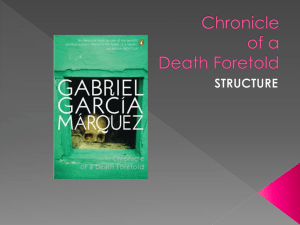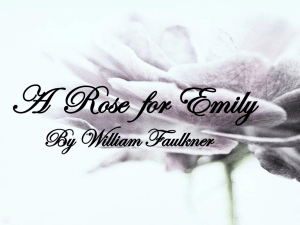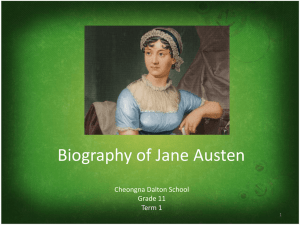Novel & Pride and Prejudice Introduction
advertisement
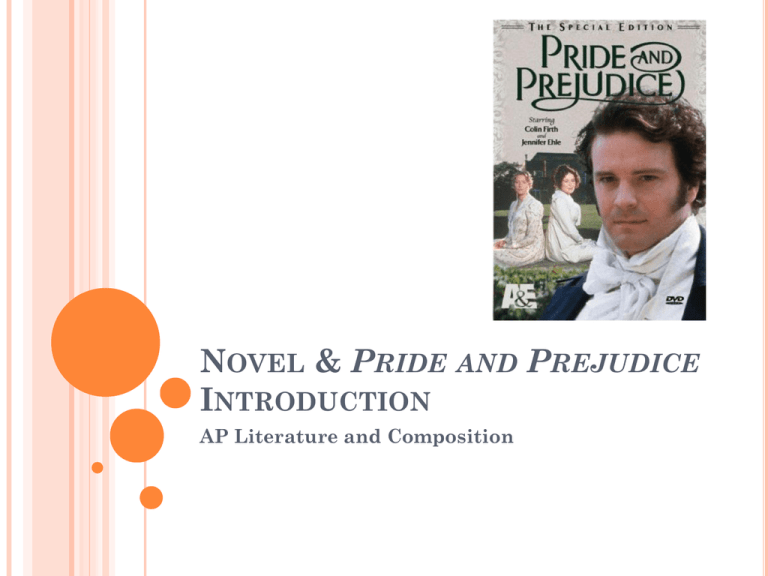
NOVEL & PRIDE AND PREJUDICE INTRODUCTION AP Literature and Composition “Single women have a dreadful propensity for being poor – which is one very strong argument in favour of matrimony.” – Jane Austen, 1816 NOVELS Novel = an extended fictional prose narrative, derived from the Italian novella, meaning “tale, piece of news” = a rather long story, filled with many characters and subplots, interlaced with motifs, symbols, and themes, with time and space to develop interrelationships and to present descriptive passages Over 600 years, the novel has been classified into different subjects: the detective novel, psychological novel, etc. as well as into modes like realism, romanticism, expressionalism, naturalism, or neoclassicism HOW TO READ A NOVEL Subplots often parallel or serve as counterpoints to the main plot line, serving to enhance the central story. Minor characters have essentially the same conflicts and goals as the major characters, but the consequences or outcomes may seem less important. Nevertheless, seeing the parallels makes understanding the major plot line less difficult. Readers should take their cue from chapter divisions: the author must have had some reason for them. We need to ask what that reason might be. When authors alternate from the “real” story and peripheral or parallel stories, look for the pattern of such organization; try to see the interrelationships of these alternating chapters. CHARACTERS The protagonist struggles toward or for someone or something; the ant(i)agonist struggles against someone or something. There are several possible conflicts (man vs. man, man vs. society, man vs. nature, man vs. himself) and more than one may occur at once, but one is usually dominant. Stock characters exist because the plot demands them. A character may be a stereotype (a librarian chuckling over her prized books, a football player who is all brawn). Characters often serve as foils for other characters, enabling us to see one or more of them better (Tom Sawyer’s Romanticism vs. Huck Finn’s Realism). Sometimes characters are allegorical, standing for qualities or concepts rather than for actual personages. ELEMENTS OF A STORY A topic is a phrase (man’s inhumanity to man, the fickle nature of fate). A theme turns a phrase into a statement (man’s inhumanity to man is barely concealed by ‘civilization’). A small change in the plot can change the theme. A motif is a detail or element of the story which is repeated throughout, and which may even become symbolic. A medical show, with many scenes alternately set in the hospital waiting room and operating room, uses elements such as the pacing, anxious parent or loved one, etc. This is a motif, a detail that helps to convince the reader that this story occurs in a hospital and that the mood is tense. ELEMENTS OF A STORY, CONT. The four elements of plot, character, theme, and setting are intertwined and largely interdependent. A work must really be read as a whole, rather than dissected and analyzed in discrete segments. Style involves language (word choice), syntax (word order, sentence type and length), the balance between narration and dialogue, the choice of narrative voice (first person participant, third person with limited omniscience), use of descriptive passages, and other aspects of the actual words on the page. NOVELS ON THE AP EXAM The AP exam never asks for specific information about a novel, such as “What was Emma Bovary’s husband’s first name?” The essay questions on novels are generally of two types: Those which give the student a brief excerpt from a specific work (which may or may not be identified) and ask for a stylistic analysis of some sort your understanding of the stylistic elements is more important than your familiarity with the novel Those which pose a general question or problem and ask the student to focus on one or more novels in order to discuss the question your familiarity with many novels will give you more options with which to work Example: “Many works use major images as emblems or symbols of a character’s virtue, vice, or the transformation from one to the other. In a well organized essay, discuss how the author employs this technique of characterization, and show how the images relate to the central theme of the work.” NOVELS ON THE AP EXAM, CONT. Books often on the AP exam have in common their significance and relevance to the human condition, as well as their merit as literary works. PRIDE AND PREJUDICE: IN THE 1800S… few middle-class women could choose not to marry or to marry simply for love. women could not enter occupations and earn their own living; one might become a governess, but this job paid little and was similar to a servant in status. A few middle class women did write, like Jane Austen, but they seldom made enough money to live on, and few women inherited wealth. (Property and money were passed down through men.) Marriage was the only path to financial security. women devoted themselves to attracting a husband. A well-rounded education was not essential, since women would spend their time in the home. YOUNG LADIES After a short Easter holiday, when Parliament adjourned and families returned to the country, the party season began. These parties revolved around the deadly serious business of marrying off the young girls of the family to eligible and wealthy young men in what some referred to as the “marriage market.” A girl’s first season marked a dramatic turning point in her life. Until she was 17 or 18 she was not considered socially alive. At dinners when guests were present she did not speak unless spoken to and then it was only to answer questions yes or no. When a girl “came out,” it meant she was formally presented and was ready to embark on an extraordinary round of balls and dances and other festive affairs. When Lady Dorothy Neville came out in 1849, she attended “50 balls, 60 parties, 30 dinners, and 25 breakfasts.” All this was with a serious goal in mind. If the girl did not get married within two to three seasons she was considered a failure. At thirty, a hopeless, permanent spinster. RULES FOR LADIES a gentleman was always introduced to a lady, never the other way around. an unmarried, under-thirty lady must never be in the company of a man without a chaperone. Except for a walk to church or to a park in the early morning, she may not walk alone but should always be accompanied by another lady, a man, or a servant. a lady never dances more than three dances with the same partner. a lady should never fail to acknowledge someone after encountering them socially unless it is absolutely necessary. RULES FOR GENTLEMEN If you meet a lady who is a good friend and who signifies that she wishes to talk to you, you turn and walk with her if you wish to converse. You do not make a lady stand talking in a street. A social inferior is always introduced to a superior and only if the latter allows the introduction. CLOTHING IN THE 1800S Dresses were high-waisted and buttoned down the back. Frocks and other dresses were made of muslin or other light material. White was a popular color. Apparel was much looser and more natural than the bell-shaped fashions that developed later in the century. Men wore linen shirts with stiff neckbands and vests. They also wore high-cut, long-tailed riding coats. PRIDE AND PREJUDICE P&P takes place in England in the early 1800s, during a time known as the Regency period (this refers to George IV, the ruler during this time – he was a regent, or substitute monarch). During this time, the American colonies revolted and gained independence, the French Revolution raged, and England faced problems with Ireland. Austen was aware of these events and they are mentioned in her novels, but they never play a major role. Austen’s depictions were especially realistic because she limited herself to the society she knew best and to a woman’s view of the world. P&P is Austen’s finest work; an early draft was titled First Impressions. THE INDUSTRIAL REVOLUTION Most of the novel’s action occurs in the homes of middle and upper class families living in the countryside not far from London. Beginning in 1780, the Industrial Revolution had sparked industrial growth and, therefore, social change. The result was a new social class. As entrepreneurs began to make money from the mechanized manufacture of commercial goods, a class, rich but untitled, rose. While titles, land, and old money still commanded respect, new money allowed this newly powerful class to move upward in the sharply delineated class structure. In P&P, the Bingley fortune has been made from industry, a fact that Miss Bingley would like to forget. Mr. Bingley’s sisters in P&P want him to buy an estate. Desirable land was often difficult to buy because such estates were often passed down within families. SOCIAL STRUCTURE Royalty • Peerage (nobles – dukes, earls, barons). Such titles were usually hereditary, passing from the father to the eldest son, and if there were no son, to another male heir. A woman who married a peer gained his status. • Baronets, knights: these titles were more numerous. While baronets were hereditary, knights were not. • Squires, other landowners who had others work their land • Tradespeople • Farmers Servants, agricultural laborers, industrial workers (Most of Austen’s characters are drawn from the gentry – the fourth level down.) • AS YOU BEGIN… P&P opens with one of the most famous first lines in English literature: “It is a truth universally acknowledged, that a single man in possession of a good fortune, must be in want of a wife.” This sentence tells us much about the author’s purpose and attitude. It states on the novel’s main themes: the relationship of money and marriage. It also sets an ironic tone. The truth about the “marriage market” was just the opposite. It was single young women who did not possess a fortune who were most in want of a husband. There is also humor in the fact that she uses dignified language to describe a crude fact of life. However, as Austen unfolds her plot and develops her characters, it becomes clear that she views one’s choice in marriage as a serious matter.
